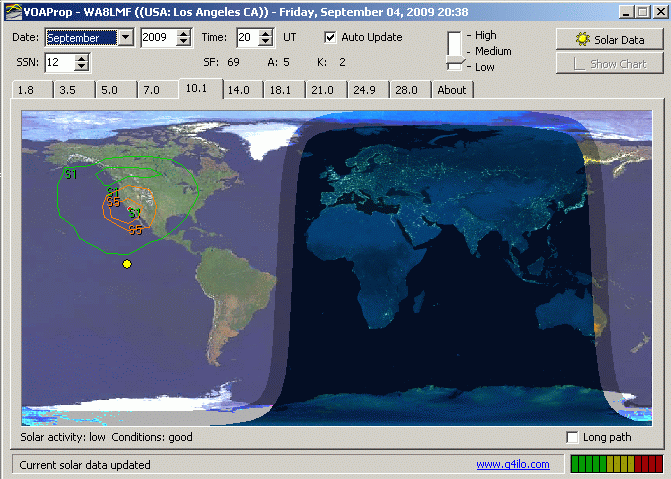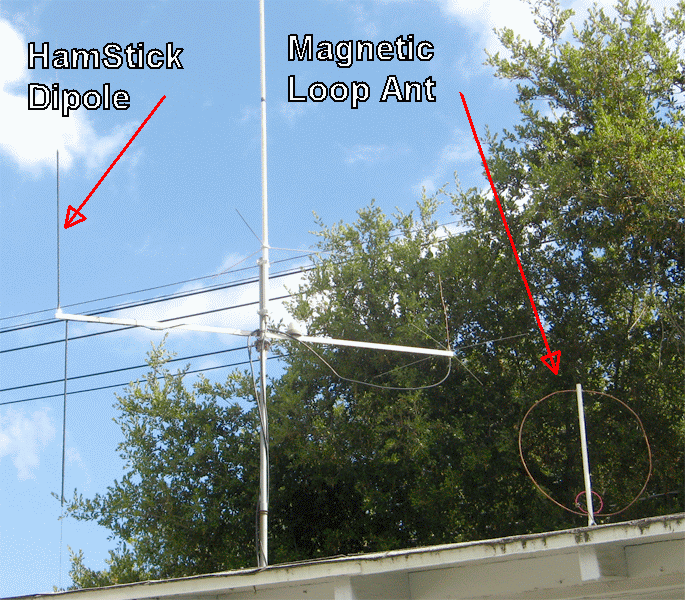| IMPORTANT Quoting "dial frequency" alone on non-FM modes is ABSOLUTELY MEANINGLESS unless you qualify it with mode (USB/LSB/DATA, etc) and the AUDIO tone frequencies used by the device in question.
|
| WA8LMF Home Page | Main Ham Radio Page | Main APRS Page | Updated 10 January 2025 |
|
Understanding the Relationships Between Audio and Radio Frequencies on SSB
|
|
Details On The New
APRS over VARA |
The vast majority of HF APRS operation in North America is conducted at the upper end of the 30-meter (10.1 MHz) band with 300 baud 200-hertz-shift "HF style" packet. The 30 meter band is open, around the clock, for long-range transmission (500-2000 miles/800-3200 Km or more) depending on time of day and solar activity.
Hams familiar with the fairly constant and predictable behavior of VHF and UHF are often bewildered by the seemly random behavior of long-range HF radio operation. Beyond-the-horizon HF radio transmission is made possible by reflection and refraction of radio signals by the electrically-charged upper layers of the earth's atmosphere known as the ionosphere. These layers are charged (ionized) by the sun's ultraviolet radiation and by streams of electrically-charged particles (the "solar wind") reaching the earth from the sun.
In turn, the amount of solar radiation varies (rather obviously) with the time of day and the time of year [i.e. number of hours of daylight], and (less obviously) the position within a somewhat-variable approximately 11-year cycle of sunspot activity. Because the charged solar particles are partially deflected and steered by the earth's magnetic field, the level of ionization (and therefore HF propagation) varies with latitude. Further, the effect of a given amount of ionization affects various parts of the HF spectrum differently.
The result of this is that range and coverage on HF is ever-changing minute-to-minute, hour-to-hour, day-to-day and season-to-season. This behavior causes far less of a problem for APRS beaconing than for normal point-to-point communications with a specific station. Dozens of fixed stations are monitoring the 30M APRS channel simultaneously, 24/7. Propagation changes that make your path to a given receiving station fade really don't matter because you are probably being received by two or three more elsewhere. The 30 meter APRS infrastructure is really a world-wide diversity receiving system tied together by the Internet.
Click Here (Warning: 500K GIF image) for an animated demonstration of changes in 30 meter coverage over a 24 hour period.
Many stations around the North American continent (and in Europe) are silently monitoring this channel (i.e. no on-air beacons) and will gate transmissions heard into the APRS Internet system. You can easily get APRS position reports to findu.com, aprs.fi, and to individual Internet-connected APRS users from the remotest parts of North America and the surrounding oceans. Even when there isn't any 2-meter infrastructure (digipeaters and igates) within hundreds of miles. This is especially useful in the interior of Canada outside of the few major cities, and in the American west away from the populated coastal areas.
The capacity (throughput) of the 30M HF system is far, far lower than one is accustomed to on 2 meters.
The 30-meter APRS infrastructure is intended primarily to support mobiles operating in remote locations with no 2-meter coverage. Routine use by fixed stations for live station-to-station chat is discouraged. Because of the high error rate due to noise and/or signal fading on HF, the no ack/retry process used during APRS messaging frequently will result in 5 or 10 retries on every message transmission. These endless retries further reduce the already limited throughput of the single 300 baud channel.
| Keep in mind the first rule of packet: ALL of a packet must be received PERFECTLY before ANYTHING will be recovered from it. |
Transmitting long strings like messages radically reduces the chances of "getting through" successfully. The probability of a packet getting corrupted by a pop of noise, fading or another station transmitting on top of you increases rapidly with packet length. For the highest probability of success, transmit the shortest possible packets.
Because of unpredictable and constantly shifting propagation on HF, digipeaters are nearly useless and highly discouraged on HF. Consider that even one digipeat retransmission DOUBLES the time you occupy the channel on each transmission. There are enough monitoring stations, dispersed geographically around the United States and Canada, to virtually guarantee that your first hop transmission will be heard and gated into the APRS Internet system by at least one (and usually several) fixed stations.
The very few digipeaters on HF respond to the path value "ECHO" rather than "RELAY" or "WIDEn-N" as on VHF. Placing "RELAY" or "WIDE" into an HF APRS path will absolutely guarantee that you WILL NOT be digipeated on HF. It will guarantee that your call will show up on Internet lists of clueless and ignorant users!
Some HF stations using dual-port TNCs (mostly Kantronics KAMs) or several single port TNCs under control of UIview can re-transmit what they hear on HF onto 2M where then (hopefully) a normal 2-meter igate will insert the packet into the APRS Internet system. The command to make this happen is "GATE" in the path. Thus you might use the path:
GATE,WIDE2-1
This would cause your packet to be retransmitted onto VHF and THEN get digipeated once on 2 meters. This can result in multiple reports entering the Internet system since an HF station may igate you directly off HF, and then later a second copy of the posit reaches the Internet after being retransmitted on 2 meters in one or more different locations, possibly hundreds or thousands of miles apart.
Note that long-delayed multiple copies of the same position report entering the APRS Internet System have, at times, caused mobile stations viewed on APRS maps to "hyper-jump" back and forth as more recent position reports get superseded by long-delayed older reports.
In the UIview program this would appear in the "Unproto address" field of "Setup, Station Setup" as:
APRS,GATE,WIDE2-1
Consider the implications of this through... You have no idea where you will be getting cross-gated from HF to 2 meters. You may get re-transmitted into numerous local VHF and UHF networks thousands of miles apart. Some people may find seeing "rare DX" on their Kenwood D700 front panels entertaining. Others may consider it out-of-area QRM.
Further, if you think you will try to get digipeated on HF, and then gate yourself onto VHF with a path like:
ECHO,GATE,WIDE2-1
think again! Since path commands are processed sequentially from left to right, you won't be gated unless you get digipeated first. Since the probability of a successful HF digipeat is very low, the probability of a successful cross-band gating is at least equally low. (This wouldn't prevent you from being igated directly from HF to the Internet; it just makes your packets needlessly longer, and therefore less likely to be decoded successfully by the igate station.)
| Unless you have some extraordinary
requirement, the best-and-most-likely-to-succeed path on HF is:
no path at all. Again, shorter is better on HF.
In the UIview program, you would enter only
APRS into the "Unproto address" field. |
Direct HF IGates provide connectivity everywhere
we didn't have in the past -- no need to digipeat or gate to VHF.
No digipeater use DOUBLES throughput on the channel.
Keep the path short; best is none at all, or
if you absolutely must, just "GATE"
No path shortens packets by 14 bytes!
This improves reliability of 40 character lines
by 20%!
| IMPORTANT Quoting "dial frequency" alone on non-FM modes is ABSOLUTELY MEANINGLESS unless you qualify it with mode (USB/LSB/DATA, etc) and the AUDIO tone frequencies used by the device in question.
|
Both the Byonics TinyTrak III and the Tigertronics TigerTrack TM-1 support 300 baud HF operation. The TinyTrak can encode the extremely short Mic-E packets. The TigerTrak produces short-form standard APRS posits, but not Mic-E. However the TigerTrak can store TEN different configurations (path, beacon rate, comment field, etc) .
An invaluable tool for visualizing changes in ever-changing HF propagation in real time is the freeware VOAprop program from G4ILO. This program uses current solar activity data to estimate coverage on any of the HF bands (including 30 meters) from any point in the world, and displays it on a greyline world map. Go to:
http://www.g4ilo.com/voaprop.html
to download this great piece of freeware.
VOAprop showing actual coverage from my 30 meter igate in Los
Angeles.

Both antennas as mounted on the
roof of my QTH in Pasadena, CA.

 to download
this amazing piece of freeware. (Opens in new window or tab.)
to download
this amazing piece of freeware. (Opens in new window or tab.)
